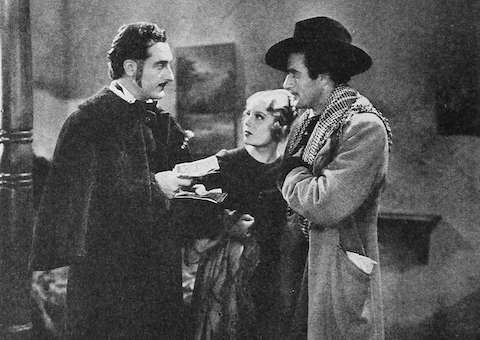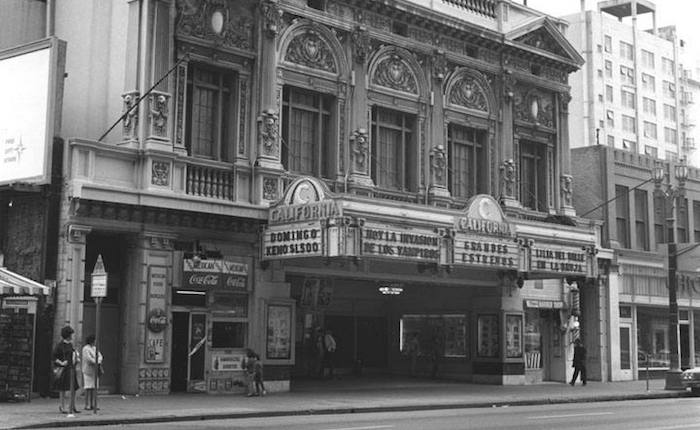
In conjunction with the 73rd FIAF Congress in Los Angeles, UCLA Film & Television Archive and the Academy Film Archive are organizing a symposium this weekend (April 29 and 30) on the production of Spanish-language cinema in Los Angeles during the golden age of the Hollywood studio system. As part of the Getty led Pacific Standard Time: LA/LA initiative, the symposium is the prequel to our three-month exhibition at the Billy Wilder Theater this fall: Recuerdos de un cine en español: Latin American Cinema in Los Angeles, 1930-1960, which will showcase as many as 40 feature films. Originally shown in Los Angeles theaters, these films constitute an authentic, local Latino/a film culture.
Few Anglo-Americans in Los Angeles remember that a vibrant Spanish-speaking cinema culture existed in the city from the 1930s through the early-1960s. Spanish-language films were in fact screened on downtown’s Main Street at the Teatro Eléctrico, Hildago, California, Mason, Roosevelt, and the Million Dollar (on Broadway), with the great majority of the films coming from Mexico, Argentina and Cuba, all of which developed indigenous film industries, while Hollywood and independent producers also supplied a significant number of Spanish-language product. Surprisingly, through control of these L.A. theaters, the Mexican film industry was able to set up an almost monopolistic distribution system, which operated in direct competition with Hollywood, literally in its own backyard. I can think of no similar oppositional system of film distribution and exhibition operating in the classic studio era. The distribution and exhibition of so-called “race films” never achieved a similar cohesion, because neither distributors nor exhibitors were African-American hands.

California Theater
The goal of the symposium, then, is to explore the making of Spanish-language films in the U.S. by the studios and independents. In both cases, producers were seeking to capitalize on the Spanish-language market of the Americas and Spain. In the 1930s, such films were produced in two phases. With the arrival of sound, Paramount, 20th Century Fox, Warner Bros., MGM, and to a lesser extent, Universal, produced Spanish-language versions of their American productions in Hollywood, or in the case of Paramount, in Astoria, NY and Paris-Joinville. Indeed, more than 78 Spanish-language versions of American films were screened in Los Angeles between 1930 and 1932, usually shot on the same sets and in the same costumes but with Spanish-speaking actors. Numerous Latin American filmmakers learned their craft on these version films before returning to help build native film industries in Latin America. However, Paramount and Fox also produced another 30 Spanish-language originals for their Latino/a stars, including Carlos Gardel and José Mojica, while independent producers released at least 15 Spanish-language originals in Hollywood rental studios. In the aftermath of Mexican cinema’s worldwide success with Allá en el Rancho Grande (dir. Fernando de Fuentes, 1936), Latin American producers working in Los Angeles again ramped up production in the years 1936-1940, producing at least 18 features locally. The existing literature on American Spanish-language films has for the most part identified these more than 30 independents as a part of Hollywood’s hegemonic push to dominate Latin America, when in fact these films should be considered as an element of this country’s minority cinema.

¡Asegure a su mujer! [Insure Your Wife] (1935)
The symposium will discuss filmmakers, stars, crafts people, exhibitors and distributors involved in the production and circulation of U.S.-made Spanish-language films. The goal being to better understand the different layers of cultural transference and exchange between the Hollywood industry, its Latin American competition, and, most importantly, its local audience. Film scholars and archivists from 10 countries, including Argentina, Mexico, Cuba, Puerto Rico, Peru, Columbia and Chile are scheduled to participate on panels. Saturday will open with a panel on L.A.’s Spanish-language producers, including papers by Robert Dickson, a pioneer in this research area, Lisa Jarvinen, the author of the most important book on Hollywood’s Spanish-language film production, Marisel Flores-Patton, who will discuss the career of Puerto Rican film producer Rafael Ramón y Cobián, and myself, who will be presenting research on the Spanish-language California production company, Cantabria Films. Participants over the two days will also include Paula Félix-Didier, Marcela Cassinelli, María Elena de las Carreras, Alejandra Espasande Bouza, Albino Álvarez Gómez, Luciano Castillo, Rogelio Agrasánchez Jr., Esteve Riambau, Iván Trujillo Bolio and Otto Padrón. Additional information can be found here.
The symposium at the Linwood Dunn Theater will conclude on Sunday night with screenings of two locally produced Spanish-language features: ¡Asegure a su mujer! [Insure Your Wife] (1935), produced by Fox’s Spanish-language production unit, and Castillos en el aire (1938), a film independently produced by Venezuelan-American bandleader, Eddie Le Baron, and newly restored by Filmoteca de la UNAM and UCLA Film & Television Archive.
< Back to Archival Spaces blog






 Mobile Navigation
Mobile Navigation

